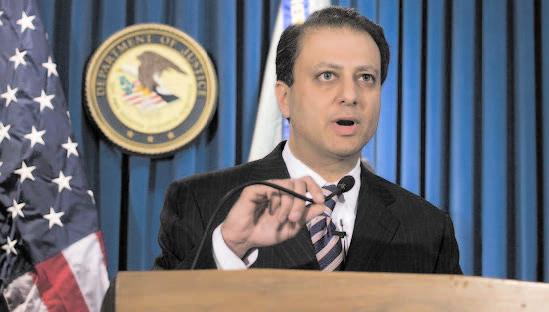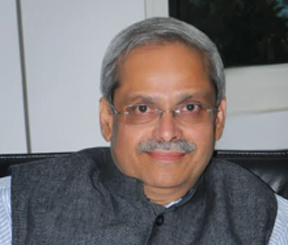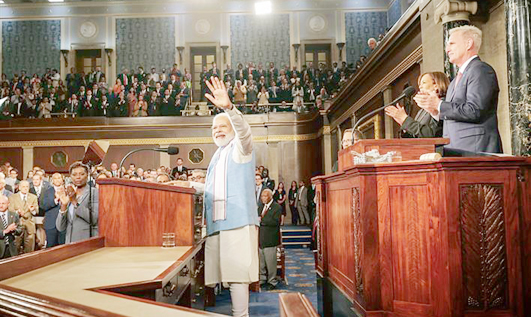
By S Nihal Singh
“Behind the new approaches being made by the two countries to revive the elan of earlier years are the geopolitical realities of Asia and the balancing of the great power status of an assertive China“, says Singh.
Above (President Barack Obama shakes hands with Indian Prime Minister Narendra Modi, Tuesday, Sept. 30, 2014, in the Oval Office of the White House in Washington. Modi’s five day visit to the U.S. was a useful bridge-building exercise in an important relationship that had gone cold)
Prime Minister Narendra Modi went to New York and Washington on an official visit and wowed both non-resident Indians (NRIs) and stay home people. Thisparadox speaks of the limits of a first visit in office of a man denied a US visa for a decade but adept at creating an impact.
While Mr. Modi himself has expressed satisfaction over his five-day visit, the verdict must be that it was a useful bridge-building exercise in an important relationship that had gone cold. The Prime Minister pressed all the right buttons, including meetings with Israeli Prime Minister Benjamin Netanyahu and representatives of the influential Jewish lobby, American politicians and office holders from President Barack Obama down and the chiefs of major companies.
If at the end of the exercise and tour de force, there was no prize catch to grasp in the way of a major investment deal, the fault was not entirely the Prime Minister’s. There were simply too many problem areas left over from the previous five years and the conclusion of those with the power and ability to invest billions of dollars was encapsuled in the adage former US President Ronald Reagan was fond of citing: Trust but verify.
US business tycoons liked what they heard from the Prime Minister, but, given the Indian record, wanted Mr. Modi to deliver what he promised. In essence, he has a six-month window, which could be stretched to the next budget, to show results. Indo-US problems fall largely into two categories: the hurdles to investments and setting up businesses more susceptible to Mr. Modi’s steamroller and knottier problems involving legislation and the states’ cooperation.
Foremost in the latter category are the introduction of GST, goods and services tax, and the elephant in the room, the nuclear question former US President George W. Bush did so much to promote and conclude. Thanks to the narrow-minded legislation the Bharatiya Janata Party did so much to help pass, the horrific penalties suppliers are saddled with have kept American companies (and some others) out of any nuclear deal.
On foreign investments, India has tied itself in knots by the kind of labor and land laws that have been passed at several levels making it arduous to acquire land and set up businesses. True, some BJP-ruled states are beginning to peel away some of the penal labor laws but it is patchy work very much in progress. And the BJP’s own bugbear, opposition to foreign direct investment in retail, is another hurdle to be crossed.
On the broader political plane, Mr. Modi had some success in moving the stalemate that had developed, partly from the United Progressive Alliance-II having lost steam and distracted by scams, partly from President Obama’s own distractions and loss of interest in India. The defense cooperation agreement has been extended by another 10 years and there has been a significant movement in cooperation in counter-terrorism operations and sharing of intelligence although neither side expected India formally to commit itself to fighting the ISIS or the Islamic State. New Delhi was pleased at the inclusion of Pakistani terrorist organizations within the ambit.
Behind the new approaches being made by the two countries to revive the élan of earlier years are the geopolitical realities of Asia and the balancing of the great power status of an assertive China. New Delhi itself is seeking to balance China, not in the sense of containing it, but in seeking to place limits on Beijing’s tendency to appropriate sea lanes and territory to its advantage through partnerships with the US, Japan and perhaps Australia. In any event, India has expressed its interest in East Asia while linking to the West.
The BJP has an advantage in practicing realpolitik in international affairs because it does not suffer from the inhibitions of the Congress Party stemming from ideological reasons. Somewhat unexpectedly, Mr. Modi has demonstrated a sure touch in his dealings with world leaders during his earlier visit to Japan and now the United States while playing host to China’s President Xi Jinping.
However, for Mr. Modi, international politics is only a route to economic diplomacy and commerce. Indeed, in his heart, he must have been disappointed that despite his marathon efforts, he could not take home even one major investment deal from his US trip. Suspicions of Indian methods of doing business and making retrospective legislation simply run too deep in the American trading community to melt their hearts to Mr. Modi’s seductive blandishments.
The essence of the argument is that Mr. Modi must now win his battles at home before much of the world will walk the red carpet he has spread out for foreign investors. In view of the BJP’s lack of numbers in the Rajya Sabha and the expedient of calling a joint session to pass legislation can only be an exception, rather than the rule, he must devise innovative ways to cross the hurdles to foreign investment.
In a sense, Mr. Modi must be rejuvenated by his American visit because his ethos is very American in the free-wheeling ways of commerce he prefers and the limitless opportunities offered to a hardy entrepreneur. Indian enterprises, particularly those in the competitive service industries, have their own legitimate grouses because projected immigration laws will further restrict the work of Indian professionals. And on the political plane, US policy is weighted in favor of Pakistan despite its misdemeanors because Washington needs it in withdrawing its troops and heavy equipment from Afghanistan.
Perhaps Mr. Modi’s appeal to the non-resident Indians to have “one foot in India” by investing at home will yield more immediate results and he was generous in distributing sweeteners not only to NRIs but also to persons of Indian origin to simplify their visa and stay requirements, also promising American citizens visas on arrival. Apparently, the Navratri fast he observed during his entire stay in the US did not interfere with his schedule.






Be the first to comment